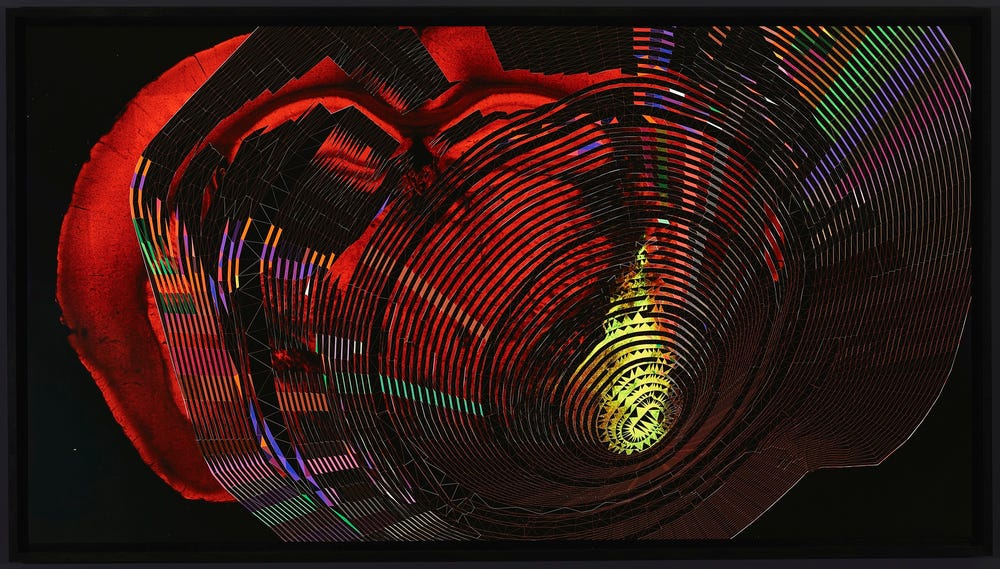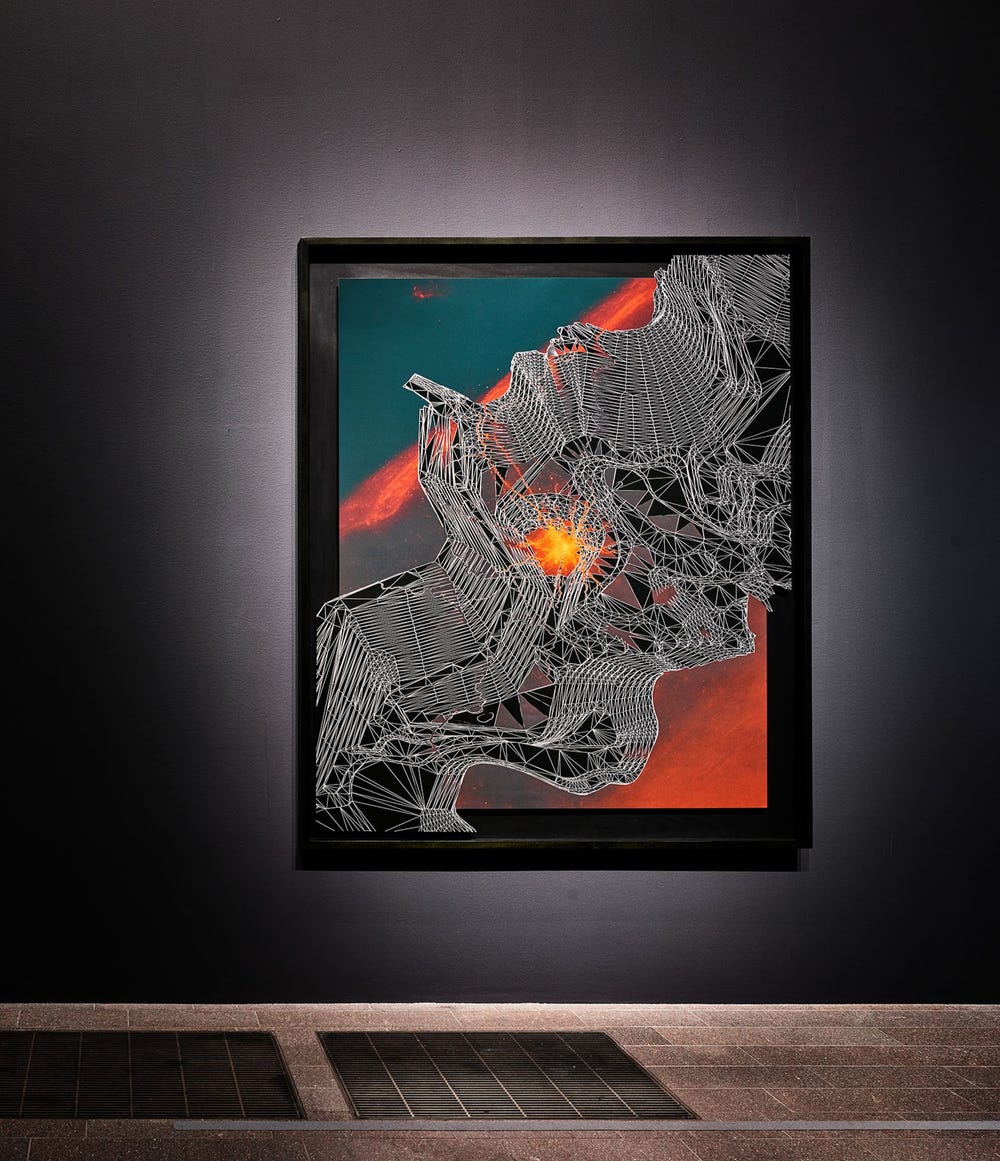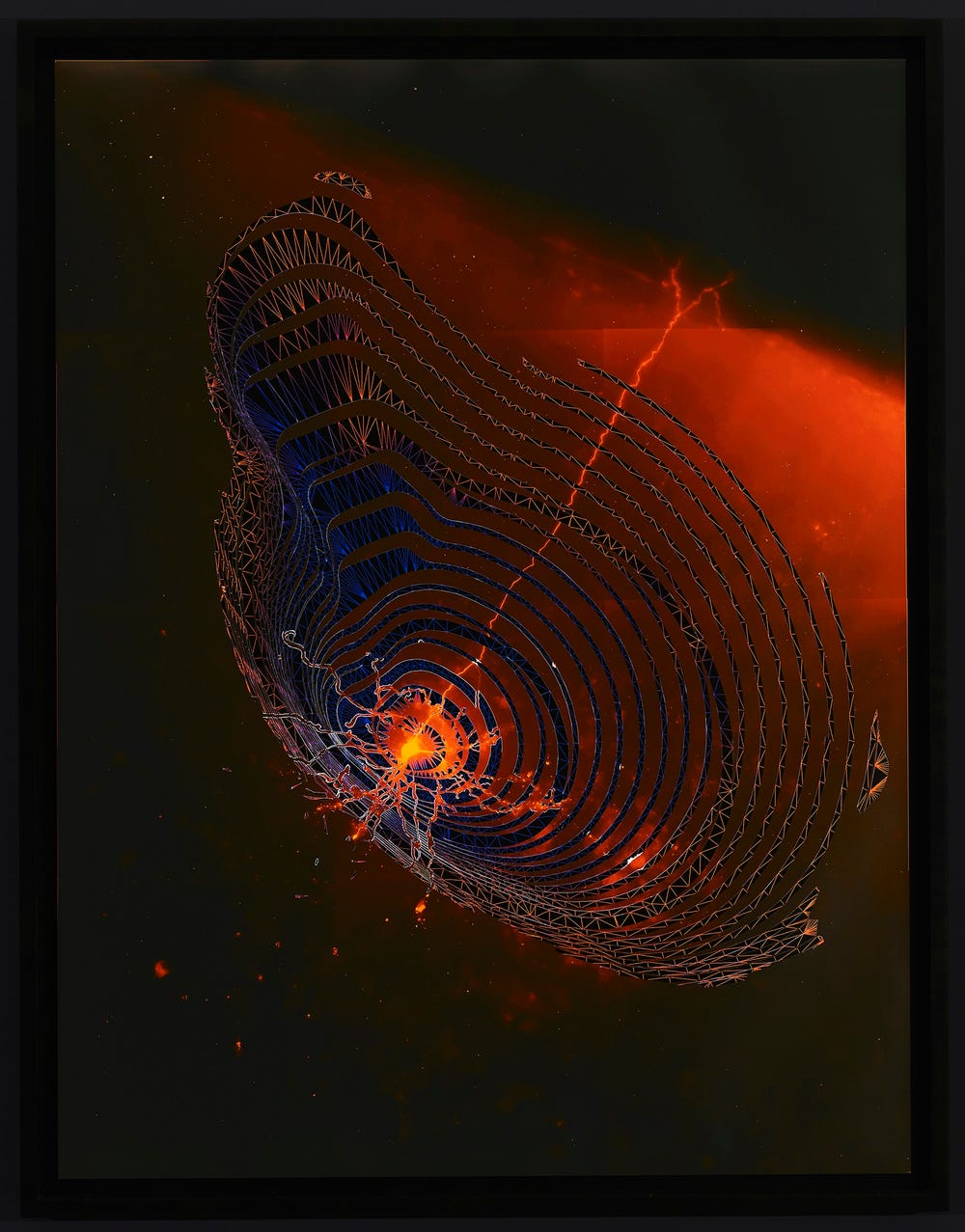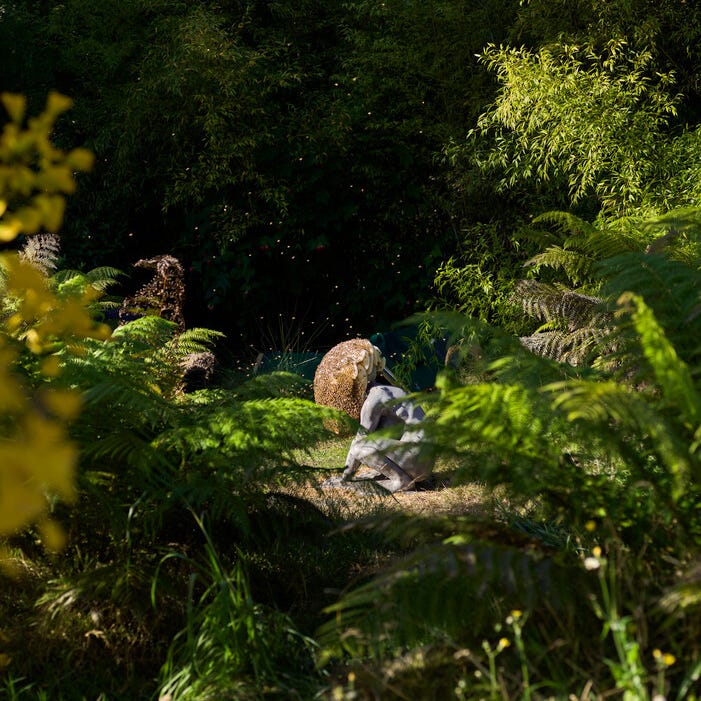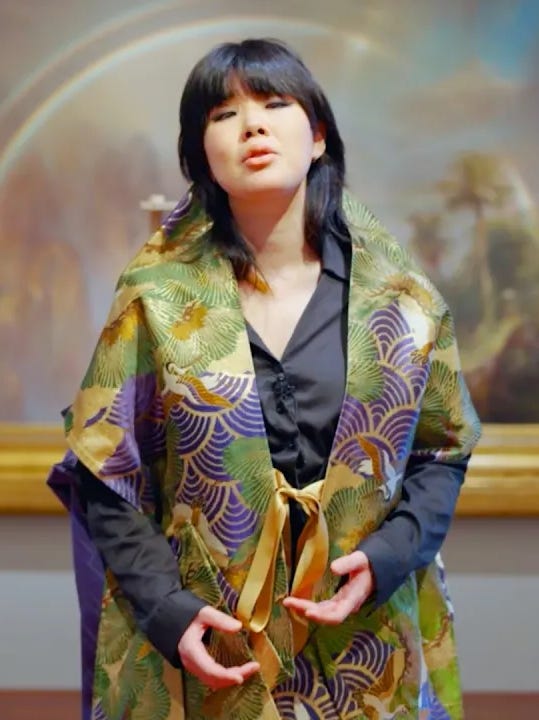Zairja Collective, “Psychepit #11 (Amygdala)”, “Neuropit #14 (Spidergram/Visual Cortex Neuron)”, “Neuropit #13 (Gradient Descent/Visual Cortex Neuron)”
By Claudia Schmucki
May 6, 2020
With nearby Silicon Valley driving the development of artificial intelligence, or AI, Uncanny Valley: Being Human in the Age of AI is the first major museum exhibition to reflect on the political and philosophical stakes of AI through the lens of artistic practice. This series highlights select artworks included in the exhibition.
Working within the tradition of political collage, the Zairja Collective builds on the metaphor of mining in order to comment on the extractive dynamics of today’s data-driven economy. The collective’s intricate pieces use imagery rarely seen by the public. They overlay actual open-pit designs sourced from mining corporations with manipulated visualizations and photographs of neuron fields produced by a bioscience institute. This fusion of collage—which combines different source images—and décollage—the interlacing of superimposed prints—generates collisions between mining pits and neurons.
By creating what it calls a “critical topology” between pits and neurons, the Zairja Collective exposes the complex strategies of AI-driven behavioral design, which applies psychological principles to machine learning and its processes of data collection and interpretation. A key tenet of the field’s approach is the principle of variable reward. The concept was first developed in the 1930s by behaviorist B. F. Skinner in his experiments with rats. It was later introduced into computational science in the late 1990s by psychologist B. J. Fogg, who spearheaded the idea of “persuasive technology.” This idea, which became foundational to behavioral design, relies on a sense of uncertainty related to the outcome of an action. If an outcome is predictable, people will only act upon immediate need, but if an outcome is unpredictable, that need gets overridden by fear of it not being met when acted upon. This fear triggers the repetition of the action to ensure that the outcome remains the same and, subsequently, addiction to performing that action. Or, as the artists put it, the principle of variable reward sets the parts of the brain dedicated to processing positive and negative emotions—the reward system and the amygdala—against each other.
As product designer Nir Eyal explores in his book Hooked: How to Build Habit-Forming Products (2013), social-media platforms have been particularly successful in applying the variable-reward principle to people’s need for attention and affirmation. In this model, fear and uncertainty are the ores extracted from the human brain. The platforms are able to meet users’ emotional needs (and undo their fears) before they have even become consciously aware of them. By creating formal confusion between neurons and pits, and insisting on the neurons’ sheer force, the Zairja Collective suggests that this asymmetric relationship can potentially be reversed.
The Zairja Collective, Psychepit #11 (Amygdala), from the series “Psychepit,” 2015–present. Collage of wire-frame design for the geo-modeling of existing mining open pits and slice of mice brain with highlighted outreach of amygdala, 59 x 108 in. (149.9 x 274.3 cm). Courtesy of the artist
In Psychepit #11, a partial wire frame of an open pit is intercut with an image of the brain region containing the amygdala—a dense, almond-shaped set of neurons that play a key role in the processing of emotions, in particular fear and aggression. Rendered here in bright lime-yellow, it is being engulfed by an expansive pit, whose spiral frame extends into sharp fangs at the bottom. The work’s spiral motif alludes to both concrete and digital acts of mining: open pits are engineered as spirals that cut through layers of earth, while the double spiral is used to visualize data in adversarial convolutional neural networks, one of the most sophisticated tools of machine learning. The spiral shapes and saturated color scheme also nod to iconic elements of psychedelic iconography, a sly reference to Silicon Valley’s appropriation of 1960s counterculture and its mind exploration.
The Zairja Collective, Neuropit #14 (spidergram/visual cortex neuron), from the series “Neuroit,” 2016–present. Collage of wire-frame design for the geo-modeling of existing mining open pits and visual cortex neuron of a mouse, 78 × 63 in. (198.1 × 160 cm). Courtesy of the artist
In Neuropit #14, a neuron from the visual cortex is surrounded by a mining pit, whose complex net of intertwined lines radiates outward, like a spiderweb gone haywire. This imagery recalls scientific experiments done with spiders, which, when given psychedelic drugs, deviated from their usual patterns of web building. It also evokes a different form of web, the spidergram, a tool developed by the Silicon Valley–based data-mining company Palantir to depict networks of data points derived from detailed and often furtive surveillance of people and their activity. The spidergram has been applied to the horizontal dynamics of terrorist sleeper cells (Palantir is credited with helping the CIA find Osama bin Laden) and to the vertical structures of companies like Airbus. Lately, it has also been behind some of the more controversial practices of the US Immigration and Customs Enforcement agency. For the Zairja Collective, collage provides a powerful means by which to produce a ricochet of meanings consistent with the idea of human behavior as the new “frontier,” one colonized by a deep, organized surveillance that maps webs of people’s connections and actions.
The Zairja Collective, Neuropit #13 (gradient descent / visual cortex neuron), from the series “Neuropit,” 2016–present. Collage of wire-frame design for the geo-modeling of existing mining open pits and visual cortex neuron of a mouse, 63 × 48 in. (160 × 121.9 cm). Courtesy of the artist
In Neuropit #13, the bottom of the pit is being torn apart by the neuron’s firing. By lending the neuron explosive force capable of disrupting the mine’s basic function, the artists allude to a fundamental limitation built into the mechanics of algorithmic data mining and, therefore, of behavioral design: an operation known as gradient descent. This optimization algorithm, reliant on trial and error, is often compared to a descent into a valley whose bottom—which in gradient descent represents zero error—is technically unreachable. As a result, the mining and prediction of human behavior is necessarily based on approximations, a fact that the Zairja Collective presents as both a limitation and an opportunity.
Text by Claudia Schmuckli, Curator in Charge of Contemporary Art and Programming; from Beyond the Uncanny Valley: Being Human in the Age of AI, Fine Arts Museums of San Francisco. Available for purchase through the Museums Stores.
Learn more about Uncanny Valley at the de Young museum.
Further Readings
Nir Eyal, cited in Ian Leslie, “The Scientists Who Make Apps Addictive,” 1843, October/November 2016, https://www.economist.com/1843/2016/10/20/the-scientists-who-make-apps-addictive
